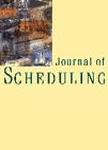版权所有:内蒙古大学图书馆 技术提供:维普资讯• 智图
内蒙古自治区呼和浩特市赛罕区大学西街235号 邮编: 010021

作者机构:Univ Calif Riverside Dept Comp Sci Riverside CA 92521 USA Ecole Polytech Dept Informat LIX Palaiseau France Charles Univ Prague Dept Appl Math CR-11800 Prague 1 Czech Republic
出 版 物:《JOURNAL OF SCHEDULING》 (调度杂志)
年 卷 期:2009年第12卷第5期
页 面:501-515页
核心收录:
学科分类:1201[管理学-管理科学与工程(可授管理学、工学学位)] 08[工学] 0802[工学-机械工程] 0812[工学-计算机科学与技术(可授工学、理学学位)]
主 题:Scheduling Fault-tolerance Real-time systems Algorithms
摘 要:We study the problem of testing whether a given set of sequenced jobs can tolerate transient faults. We present efficient algorithms for this problem in several fault models. A fault model describes what types of faults are allowed and specifies assumptions on their frequency. Two types of faults are considered: hidden faults, that can only be detected after a job completes, and exposed faults, that can be detected immediately. First, we give an O(n)-time fault-tolerance testing algorithm, for both exposed and hidden faults, if the number of faults does not exceed a given parameter k. Then we consider the model in which any two faults are separated in time by a gap of length at least Delta, where Delta is at least twice the maximum job length. For exposed faults, we give an O(n)-time algorithm. For hidden faults, we give an algorithm with running time O(n(2)), and we prove that if job lengths are distributed uniformly over an interval [0, p(max)], then this algorithm s expected running time is O(n). Our experimental study shows that this linear-time performance extends to other distributions. Finally, we provide evidence that improving the worst-case performance may not be possible, by proving an Omega(n(2)) lower bound, in the algebraic computation tree model, on a slight generalization of this problem.